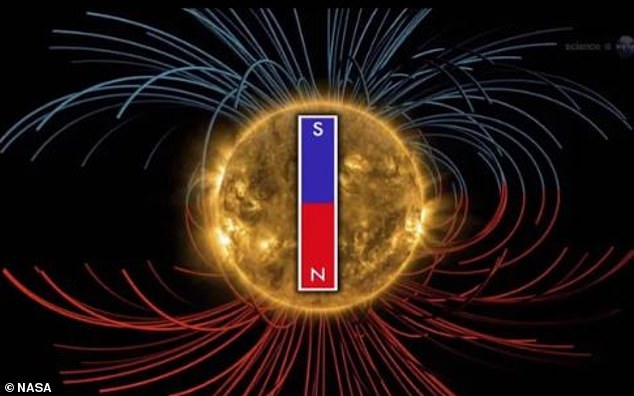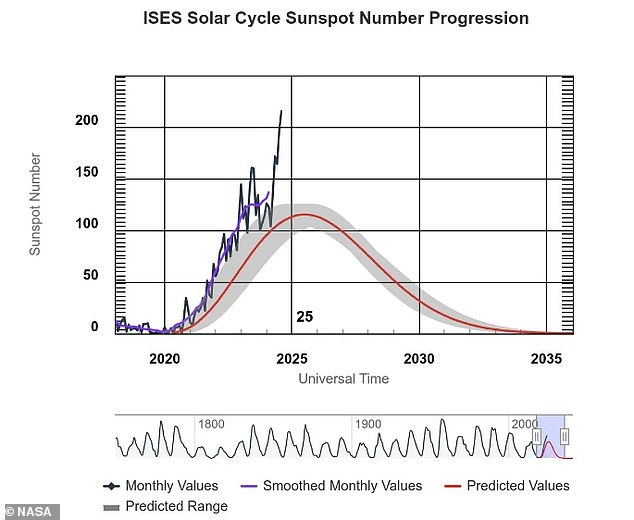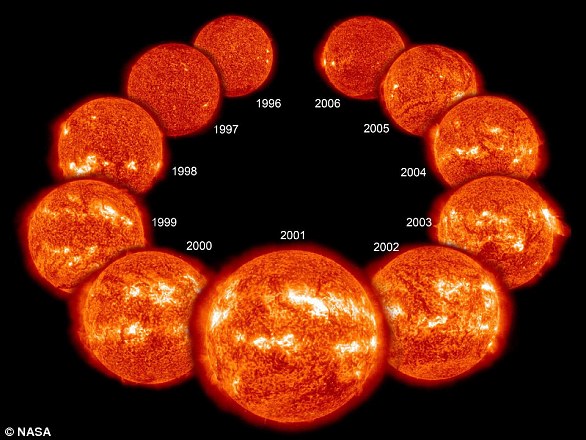Urgent warning about intense solar storms strong enough to paralyze the internet for WEEKS – as NASA confirms we’ve reached the explosive peak in the sun’s 11-year cycle
Every eleven years, our sun becomes a chaotic sphere that shoots huge bursts of energy towards Earth – a period known as ‘solar maximum’.
These bursts of energy are responsible for the stunning Northern Lights shows we have been treated to in recent months.
However, they can also disrupt internet and GPS satellites in orbit, causing weeks of power outages.
Unfortunately, scientists have confirmed that solar maximum has officially arrived and could continue for the next twelve months.
So while the chances of seeing the aurora will increase, so will the chances of a global internet blackout.
In a conference call, NASA, the National Oceanic and Atmospheric Administration (NOAA) and the Solar Cycle Prediction Panel confirmed that the sun has reached its maximum solar period, which could continue into the coming year.
“During solar maximum, the number of sunspots, and therefore the amount of solar activity, increases,” said Jamie Favors, director of NASA’s space weather program.
About every eleven years the sun goes through a so-called ‘solar maximum’, during which many bizarre dark spots appear on its surface
‘This increase in activity provides an exciting opportunity to learn more about our nearest star, but is also causing real impacts on Earth and across our solar system.’
However, it is not yet known when exactly the maximum activity on the sun will peak during this solar activity.
Elsayed Talaat, director of space weather operations at NOAA, added: “Although the Sun has reached its maximum solar period, the month in which the Sun’s solar activity peaks will not be identified for months or years.”
It is not only essential light and heat that the Earth receives from the sun, which is on average 150 million kilometers away.
Our star is a huge ball of electrically charged hot gas that moves and creates a powerful magnetic field, officially known as the dipole field.
This dipole field – which extends from one pole of the Sun to the other, just like Earth’s – goes through a cycle called the solar cycle.
About every eleven years, the sun’s magnetic field completely reverses, meaning the north and south poles switch places.
At the beginning of the solar cycle (just after the transition), the surface of the sun has the fewest black spots, also called ‘sunspots’.

Every 11 years, the Sun’s magnetic dipole field (which extends from one pole of the Sun to the other, just like Earth’s) completely reverses, meaning the Sun’s north and south poles switch places. This marks the beginning of the solar cycle, which lasts about eleven years. Each solar cycle starts with few sunspots, before moving to the largest number of sunspots (solar maximum) and running out of sunspots again
The middle of the solar cycle is solar maximum, when the Sun has the most sunspots.
And during this solar maximum, the most violent space weather is expected, commonly known as solar storms.
Fortunately, solar storms are not dangerous to humans.
However, they can affect both satellites in orbit and electricity grids on Earth.
“The likelihood of these solar storms increases when the number of sunspots is high,” Dr Dibyendu Nandi, a physicist from the IISER Kolkata Center of Excellence in Space Sciences in India, told MailOnline.
‘The most intense storms can sometimes result in catastrophic orbital decay of low-Earth orbit satellites, disrupting satellite-based services such as communications and navigation networks.
‘They can also cause strong disturbances in the geomagnetic field, knocking out power grids in high latitudes.
“Of course, they also create beautiful auroras, so we can expect 2024 to be a good year for auroras hunters.”

This graph shows the number of sunspots on the Sun’s surface as we enter and exit ‘solar maximum’
A 2021 study published by a scientist at the University of California, Irvine found that the internet could be crippled for weeks due to a major solar storm.
This is due to vulnerabilities in the world’s vast network of undersea communications cables.
The electromagnetic fluctuations caused by intense solar storms cannot directly damage the fiber-optic cables that form the backbone of the Internet.
However, they do have the potential to disable the signal boosters along submarine cables needed to maintain connections over long distances.
The study predicted that the chance of a solar storm that could cause catastrophic disruptions in the next decade is between 1.6 and 12 percent.
In 1859, a massive solar storm known as the Carrington event sent a powerful solar blast toward Earth, disrupting communications on the ground.
If such an event were to occur in today’s world, the consequences would be catastrophic for our communications systems.
Smaller storms occurred in 1921 and 1989 – the latter notably knocking out Hydro-Québec’s power grid, causing a nine-hour blackout in northeastern Canada.
Scientists won’t be able to determine the exact peak of this maximum solar period for months, because it won’t be identifiable until they track a consistent decline in solar activity after that peak.
However, scientists have determined that the last two years on the Sun have been part of this active phase of the solar cycle, due to the consistently high number of sunspots during this period.
Scientists expect the maximum phase to last about a year before the sun enters the waning phase, which leads back to the ‘solar minimum’ – at the beginning of the solar cycle, when the sun has the fewest sunspots.

